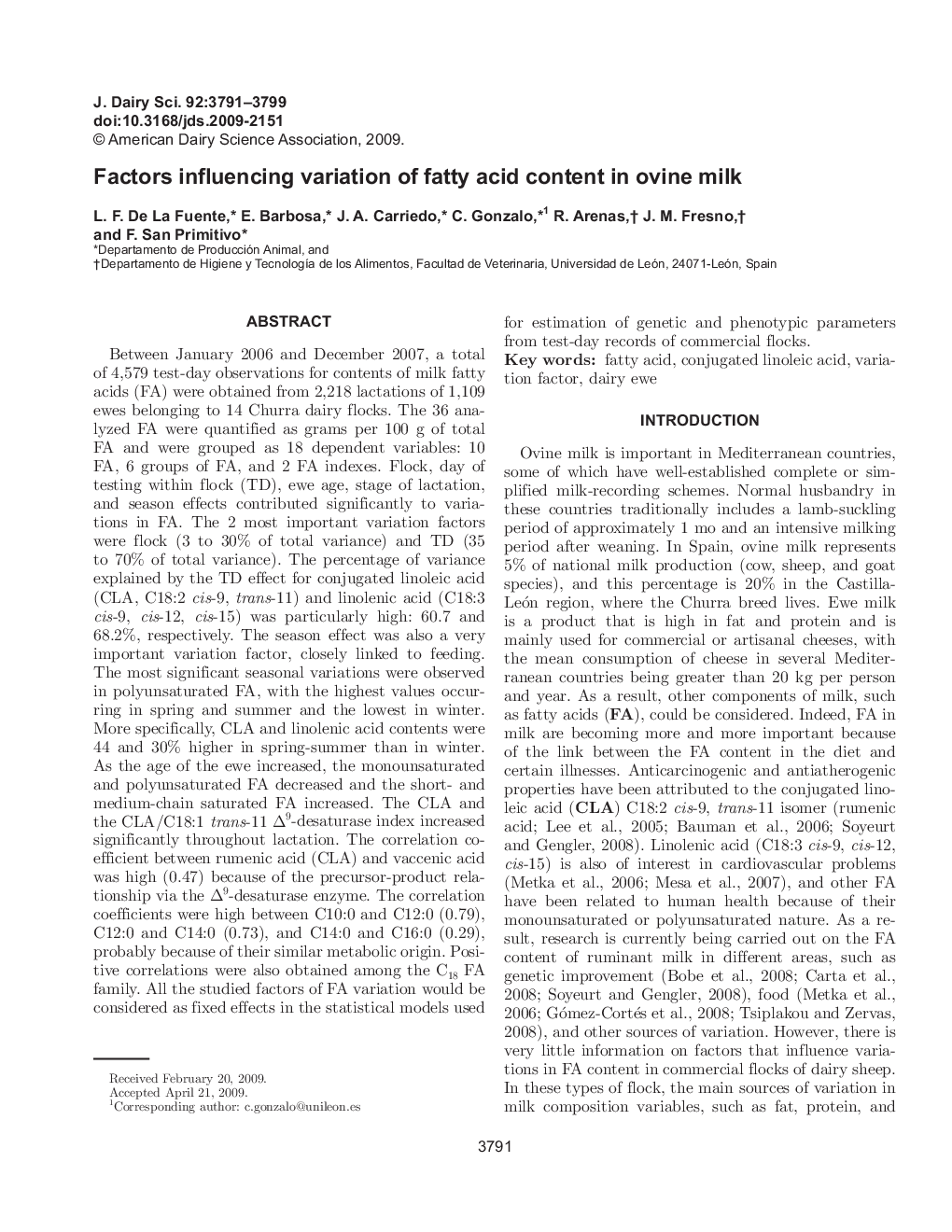| کد مقاله | کد نشریه | سال انتشار | مقاله انگلیسی | نسخه تمام متن |
|---|---|---|---|---|
| 2439059 | 1108086 | 2009 | 9 صفحه PDF | دانلود رایگان |
عنوان انگلیسی مقاله ISI
Factors influencing variation of fatty acid content in ovine milk
دانلود مقاله + سفارش ترجمه
دانلود مقاله ISI انگلیسی
رایگان برای ایرانیان
کلمات کلیدی
موضوعات مرتبط
علوم زیستی و بیوفناوری
علوم کشاورزی و بیولوژیک
علوم دامی و جانورشناسی
پیش نمایش صفحه اول مقاله

چکیده انگلیسی
Between January 2006 and December 2007, a total of 4,579 test-day observations for contents of milk fatty acids (FA) were obtained from 2,218 lactations of 1,109 ewes belonging to 14 Churra dairy flocks. The 36 analyzed FA were quantified as grams per 100Â g of total FA and were grouped as 18 dependent variables: 10 FA, 6 groups of FA, and 2 FA indexes. Flock, day of testing within flock (TD), ewe age, stage of lactation, and season effects contributed significantly to variations in FA. The 2 most important variation factors were flock (3 to 30% of total variance) and TD (35 to 70% of total variance). The percentage of variance explained by the TD effect for conjugated linoleic acid (CLA, C18:2 cis-9, trans-11) and linolenic acid (C18:3 cis-9, cis-12, cis-15) was particularly high: 60.7 and 68.2%, respectively. The season effect was also a very important variation factor, closely linked to feeding. The most significant seasonal variations were observed in polyunsaturated FA, with the highest values occurring in spring and summer and the lowest in winter. More specifically, CLA and linolenic acid contents were 44 and 30% higher in spring-summer than in winter. As the age of the ewe increased, the monounsaturated and polyunsaturated FA decreased and the short- and medium-chain saturated FA increased. The CLA and the CLA/C18:1 trans-11 Î9-desaturase index increased significantly throughout lactation. The correlation coefficient between rumenic acid (CLA) and vaccenic acid was high (0.47) because of the precursor-product relationship via the Î9-desaturase enzyme. The correlation coefficients were high between C10:0 and C12:0 (0.79), C12:0 and C14:0 (0.73), and C14:0 and C16:0 (0.29), probably because of their similar metabolic origin. Positive correlations were also obtained among the C18 FA family. All the studied factors of FA variation would be considered as fixed effects in the statistical models used for estimation of genetic and phenotypic parameters from test-day records of commercial flocks.
ناشر
Database: Elsevier - ScienceDirect (ساینس دایرکت)
Journal: Journal of Dairy Science - Volume 92, Issue 8, August 2009, Pages 3791-3799
Journal: Journal of Dairy Science - Volume 92, Issue 8, August 2009, Pages 3791-3799
نویسندگان
L.F. De La Fuente, E. Barbosa, J.A. Carriedo, C. Gonzalo, R. Arenas, J.M. Fresno, F. San Primitivo,